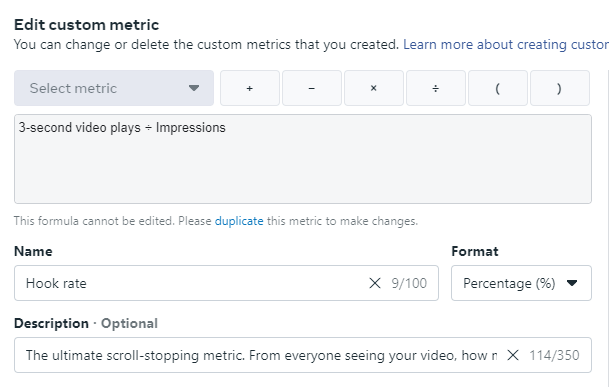Table of contents


Table of contents
Hook rate and hold rate.
Maybe you’ve heard people talk about this metric. But where in your Ads Manager can you actually find this?
What is Hook Rate and Hold Rate?
The hook rate and hold rate metrics are made by creating a custom metric inside Facebook Business Manager.
Hook Rate is the percentage that shows how scroll-stopping your ad is by calculating the percentage of 3-second video plays in relation to ad impressions.
Hold Rate is the percentage that shows you – out of all the people who stopped scrolling (3-second video plays) – how many people finished the video (ThruPlays).
How to create Hook Rate metric
To create the Hook Rate metric, go to your Facebook Business Manager and open your Ads Manager account.
Go to Columns > Customise columns.
Then in the popup window, click Create custom metric.
In the next window, simply copy the exact details in the image below:
Then add it to your custom column set. Don’t forget to save.
How to create Hold Rate metric
To create the Hold Rate metric, follow the first few steps in previous explanation of Hook Rate.
Ready to create the metric? Copy the details in the below screenshot:
Again add it to your custom column set and don’t forget to save.
How to make sense of the data?
What we’re trying to do is see which videos are better at grabbing AND keeping the attention.
There’s 2 goals here:
- Stop the scroll.
- Watch to completion after stopping the scroll.
In the example below only one video ad is used per ad set, and inside each ad set the SAME video is used.
So what can we say from the above data?
It seems that it’s 2 times more likely for a scroll to be stopped when that one video – used in both ad sets – is shown to the lookalike audience of website visitors (when compared to the lookalike audience of Instagram page followers).
In other words, the first 3 seconds of the same video resonate more with the LAL website visitor audience than with the LAL IG page followers.
The hold rates don’t differ that much.
How to optimize videos for hook rate and hold rate?
For the best comparison, you want to test multiple videos inside the same ad set to determine which video is better at grabbing and keeping the attention.
The previous example is not a good example to clearly explain how to optimize the video for hook and hold rates. Below I’ll explain what is.
The best way to do it is to get a baseline first. ‘Buy’ knowledge (=data) on what makes your audience tick, by running tests with video advertising for a while.
Try this:
- Run an ad set with 3 different video ads for €15 per day for 7 days (cost €105).
- After this week you should have enough data to know which of those 3 different video ads are better at grabbing and keeping attention.
- Write down the characteristics of the best scroll stopper (= highest % Hook Rate), and write down the characteristics of the video that is best at keeping the attention (= highest % Hold Rate).
- Analyze the bad performers: what makes it so that fewer people stop scrolling or view to completion?
- Rinse and repeat. At the montage level of video editing, use your knowledge of Hook Rate to come up with better video ads.
Examples of scroll-stopping ads
Below you find 2 examples that I came across and screen-recorded:
1. Cloudpillo
Cloudpillo is a Dutch brand that sells customizable sleeping cushions.
Why the first 3 seconds of their video work so well is because of the unusual visuals.
It is a compelling visual of a very specific industrial process where seemingly the cushion foam is created.
When you first see this, nobody knows about this. That’s the big influence on Hook Rate.
The disconnect between the the voice-over where they talk about neck pain combined with the visual adds to the effect.
Think about neck pain and seeing this very specific industrial process, strange combination if you ask me.
Not being able to connect both parts creates a curiosity gap that positively affects the Hold Rate.
2. Dr. Squatch
Dr. Squatch is an American personal care brand for men.
Why the first 3 seconds of the video work so well is because of the close-up and the absurdness of the content.
A car running over a shampoo bottle?
When the bottle pops the contents are pushed closely towards the camera. This is very uncommon.
The voice-over about dry skin in the first 3 seconds is another disconnect adding to the curiosity gap. Dry skin and cars running over bottles of shampoo don’t add up.
Dr Squatch’s ads are quite genius. You can browse many more (900 live ads at the time of writing) here in the Facebook Ads library.
3. Mother’s Earth
Mother’s Earth is a Dutch brand that sells eco-friendly laundry sheets.
I found the first 3 seconds looked familiar. Your thoughts?
So…. Who was first, Mother’s Earth or Dr. Squatch? (The latter has been on the market for quite a while)
This specific hook works very well for grabbing the attention.
📨
Subscribe to my newsletter to get actionable tips to improve your website.
👋 Hey, thanks for reading all the way through
Please join me in the comments below and get a reply within the day.









